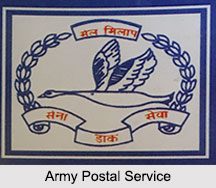 Army Postal Service functions as a part of the countrywide postal setup but administratively it is under Indian Army. In 1688, the first Post Office was established. Warren Hastings revised the regulations for the Post Office in 1774.
Army Postal Service functions as a part of the countrywide postal setup but administratively it is under Indian Army. In 1688, the first Post Office was established. Warren Hastings revised the regulations for the Post Office in 1774.
Field Post Office or FPO is now a well recognised term used for a post office functioning in the field of military operations or providing postal service to a military formation or unit in military camp. Then Field Post Offices accompanying expeditionary forces abroad were called "Field Force Post Offices" and those provided to camps of exercise and military campaigns were called "Camp Post Offices".
The Army Postal Organisation of today is based on the pattern evolved by the British. The first Indian Field Post Office was sent from Bombay to Bushire to accompany the Persian Expedition. Indian Field Post Offices accompanied British and Indian Expeditionary Forces to Abyssinia in 1867, to Afghanistan, Malta and Cyprus in 1878, to Egypt in 1882 and 1885, to China in 1900, to Somaliland in 1903 and to Tibet in 1904.
Ancient Army Postal Services
Earlier, Indian rulers had efficient courier systems as part of their administrative set-up. When Babur advanced into the Indo-Gangetic plain, the first things he did was to get the road between Kabul and Agra measured. Once done, he established postal stations of 6 horses each at every 57.6 kilometres of the road.
Sher Shah Suri linked all parts of his kingdom with an efficient road system and got them built in a short time. He designated each of them as Postal Stations, where 6 horses were always kept to relay Government orders. Under this system, it took less than a week for a message to reach from Bengal to Punjab.
Independent Evolution of Army Postal Service
In 1778, the commander-in-chief were authorised to employ "Qasidas" or "Cosids" (Couriers) for dispatch of correspondence. In 1778, the commanding officer of large frontier forces were authorised to spend Rupees 150 for employing a "Dak Moonshi" (Clerk) and Harkar as for running the extended mail lines. The Army used Harkaras to maintain contact with the nearest point on these mail lines.
In 1800, Government of Bengal issued orders on Postal arrangements for the Army to deliver their fully prepaid mail to the nearest post office for onward transmission. In case of large troops, the specified commander would ask the Deputy Post Master to send a "Mutsuddy" and peon with them to transact postal business. In 1805, the first "Postmaster" for the Army appeared on the scene. Thereafter one staff officer was appointed as Postmaster at the Headquarters of all field Forces.
Early Postal Systems in India
The early postal systems that existed in India before the Army Postal Service evolved are as follows:
1. The Pigeon Post: During Mughal rule, carrier-pigeons were used for conveying letters by officials of the state. Medieval Persian literature refers to it as "Kabutar-i-Namabar" meaning "the pigeon messenger".
2. The Foot Post: Runner service was the most extensively organised postal service during the Mughal reign. Royal runners were posted in villages, taking their turns of duty throughout the day and night. They took over letters immediately on its arrival, ran with it to the next village.
3. The Horse Post: Mounted couriers were deployed on important highways at every 16 kilometres, where 2 horsemen were ready to carry messages. Through them, nobles and Khans were entitled to send letters, petitions and messages on urgent matters to the Emperor.
Growth of Army Postal Service
The growth of the Indian Army Postal Service from an ad hoe war time organization into a full-fledged service of the Army is an interesting phenomenon of the post independence India.
The World War I saw the sprouting up of 300 to 400 Indian FPOs in France, Egypt, Mesopotamia, East Africa, Persia, Palestine, Turkey, North West Frontier and Afghanistan. With the end of World War II, came the process of winding up of the Indian Army postal organisation which shrank in 1947 when India became independent.
The tradition of "excellent" service by special post offices provided to Indian expeditionary forces before independence, defending the country in operations or keeping vigil on the borders after Independence continues till today.






